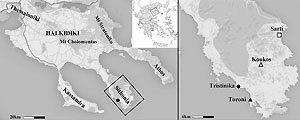The sediment core from Tristinika coastal marsh in the northern part of Central Greece is the first complete record of vegetation transformation over the last 3.5 millennia. The palynological investigation of the above mentioned core reveals a very strong correlation between vegetation development and human settlement in Halkidiki. Considering the climate variability of this period and the correlation of the pollen data to the extended archaeological and historic archives we can clarify the strongly interactive human-environment relationship, in the vicinity of Torone (which was an important ancient harbour in Halkidiki) and Mt Athos (with a great monasteric history).
The pollen record indicates that signs of olive (Olea) and cereal cultivation appear in the Mycenaean era, but the extensive Olea cultivation is taking place during the Archaic/mid-Roman era and post-Byzantine/modern era. Systematic cereal cultivation starts in the Archaic and peaks in late-Roman/early-Byzantine era; then, it returns in the post-Byzantine era and peaks again in Ottoman/Modern Times. Grazing is the most regular human activity in the area and the main reason for the expansion of Erica heaths.
For details we would like to point to the paper of S. Panajiotidis and M.L. Papadopoulou in the Journal of Archaeological Science: Reports 7, 2016, 138–145.
 Map of Halkidiki showing coring site (Tristinika). Map of Halkidiki showing coring site (Tristinika).Source: Map modified after Panajiotidis & Papadopoulou 2016 |
















